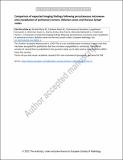Comparison of expected imaging findings following percutaneous microwave and cryoablation of pulmonary tumors: ablation zones and thoracic lymph nodes
Author(s)
Wrobel, Maria M.; Cahalane, Alexis M.; Pachamanova, Dessislava; Leppelmann, Konstantin S.; Silverman, Stuart G.; Sharma, Amita; Shyn, Paul B.; Mercaldo, Nathaniel D.; Fintelmann, Florian J.; ... Show more Show less
Download330_2022_8905_ReferencePDF.pdf (2.292Mb)
Publisher Policy
Publisher Policy
Article is made available in accordance with the publisher's policy and may be subject to US copyright law. Please refer to the publisher's site for terms of use.
Terms of use
Metadata
Show full item recordAbstract
Abstract
Objective
To compare temporal changes of ablation zones and lymph nodes following lung microwave ablation (MWA) and cryoablation.
Methods
This retrospective cohort study compared lung ablation zones and thoracic lymph nodes following MWA and cryoablation performed 2006–2020. In the ablation zone cohort, ablation zone volumes were measured on serial CT for 12 months. In the lymph node cohort, the sum of bidimensional products of lymph node diameters was measured before (baseline) and up to 6 months following ablation. Cumulative incidence curves estimated the time to 75% ablation zone reduction and linear mixed-effects regression models compared the temporal distribution of ablation zones and lymph node sizes between modalities.
Results
Ablation zones of 59 tumors treated in 45 sessions (16 MWA, 29 cryoablation) in 36 patients were evaluated. Differences in the time to 75% volume reduction between modalities were not detected. Following MWA, half of the ablation zones required an estimated time of 340 days to achieve a 75% volume reduction compared to 214 days following cryoablation (p = .30). Thoracic lymph node sizes after 33 sessions (13 MWA, 20 cryoablation) differed between modalities (baseline–32 days, p = .01; 32–123 days, p = .001). Following MWA, lymph nodes increased on average by 38 mm2 (95%CI, 5.0–70.7; p = .02) from baseline to 32 days, followed by an estimated decrease of 50 mm2 (32–123 days; p = .001). Following cryoablation, changes in lymph nodes were not detected (baseline–32 days, p = .33).
Conclusion
The rate of ablation zone volume reduction did not differ between MWA and cryoablation. Thoracic lymph nodes enlarged transiently after MWA but not after cryoablation.
Key Points
• Contrary to current belief, the rate of lung ablation zone volume reduction did not differ between microwave and cryoablation.
• Transient enlargement of thoracic lymph nodes after microwave ablation was not associated with regional tumor spread and decreased within six months following ablation.
• No significant thoracic lymph node enlargement was observed following cryoablation.
Date issued
2022-06-15Department
Sloan School of ManagementPublisher
Springer Berlin Heidelberg
Citation
Wrobel, Maria M., Cahalane, Alexis M., Pachamanova, Dessislava, Leppelmann, Konstantin S., Silverman, Stuart G. et al. 2022. "Comparison of expected imaging findings following percutaneous microwave and cryoablation of pulmonary tumors: ablation zones and thoracic lymph nodes."
Version: Author's final manuscript